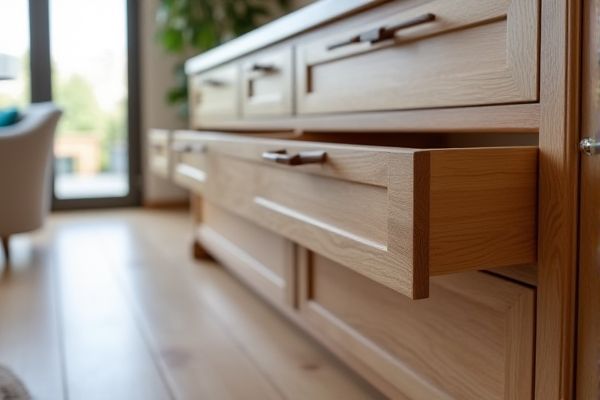
Soft-close drawers eliminate slamming by gently closing with hydraulic mechanisms, enhancing durability and providing a quieter, more refined user experience compared to standard drawers that close abruptly. Discover how choosing the right drawer type can transform your space by reading the rest of the article.
Table of Comparison
| Feature | Soft-Close Drawers | Standard Drawers |
|---|---|---|
| Closing Mechanism | Controlled, slow closing with automatic pull-in | Manual closing, often with a noise |
| Noise Level | Quiet and smooth | Loud, slamming sound possible |
| Durability | Reduced wear and tear due to cushioning | More prone to damage from slamming |
| Cost | Higher upfront cost | More affordable |
| Maintenance | Requires occasional adjustment of soft-close mechanism | Minimal maintenance needed |
| Installation | More complex, may require professional | Simple and straightforward |
| User Experience | Enhanced comfort and convenience | Basic functionality |
Overview of Soft-Close and Standard Drawers
Soft-close drawers feature built-in damping mechanisms that slow the drawer's motion, preventing slamming and reducing wear on hardware, while standard drawers rely on manual force to close, often resulting in noise and potential damage over time. The soft-close system enhances user experience by providing smoother, quieter operation and increased durability. Choosing soft-close drawers improves Your kitchen or furniture functionality and longevity compared to traditional, standard drawer designs.
How Soft-Close Drawer Mechanisms Work
Soft-close drawer mechanisms use hydraulic dampers or pneumatic pistons to slow the drawer's movement as it approaches the closed position, preventing slamming. This system engages a catch that gently pulls the drawer shut after reaching a certain point, ensuring smooth and quiet operation. Unlike standard drawers that rely solely on sliding rails, soft-close drawers enhance durability and reduce noise with these integrated damping components.
Standard Drawers: Traditional Functionality
Standard drawers offer traditional functionality with a straightforward design that prioritizes ease of use and cost-efficiency. They typically feature simple glides and manual closing mechanisms, providing reliable storage without advanced noise reduction or cushioning. This makes standard drawers a practical choice for budget-conscious projects where high-tech features like soft-close mechanisms are unnecessary.
Durability: Soft-Close vs Standard Drawers
Soft-close drawers feature hydraulic dampers that slow the closing action, significantly reducing wear and tear on drawer components compared to standard drawers, which often rely on simple metal or plastic glides. This mechanism minimizes impact forces, thereby extending the lifespan of both the drawer slides and the cabinet structure. In contrast, standard drawers are more prone to damage from slamming, resulting in quicker degradation of materials and more frequent maintenance or replacements.
Noise Reduction Benefits of Soft-Close Drawers
Soft-close drawers significantly reduce noise by using hydraulic dampers that slow the drawer's closing motion, preventing loud slams commonly heard with standard drawers. This mechanism not only minimizes disruptions in quiet environments such as bedrooms and offices but also extends the lifespan of cabinetry by reducing impact wear. Compared to traditional drawers, soft-close systems offer a smoother, quieter experience that enhances overall home comfort and durability.
Safety Considerations for Both Drawer Types
Soft-close drawers reduce the risk of finger injuries by closing gently and quietly, preventing sudden slams. Standard drawers may pose safety hazards due to abrupt closure, increasing the chance of pinched fingers or accidental damage. You should consider soft-close mechanisms in environments with children or frequent use to enhance overall safety.
Cost Comparison: Soft-Close vs Standard Drawers
Soft-close drawers generally cost 20-30% more than standard drawers due to advanced damping mechanisms and hardware. While standard drawers are more affordable upfront, soft-close models offer long-term value by reducing noise, wear, and potential damage. Investing in soft-close drawers can increase overall cabinet durability and enhance user experience despite the higher initial price.
Installation and Maintenance Differences
Soft-close drawers require precise alignment during installation to ensure the damping mechanism functions properly, whereas standard drawers offer easier installation with fewer alignment constraints. Maintenance for soft-close drawers involves occasional lubrication of the dampers and checking for debris that could hinder smooth closing, while standard drawers typically need less frequent attention but may require periodic adjustment of slides. Over time, soft-close mechanisms might need replacement parts to maintain performance, contrasting with the generally simpler upkeep of standard drawer systems.
Aesthetic and Design Impacts
Soft-close drawers enhance your kitchen's aesthetic by offering a sleek, seamless look with minimal gaps and smooth, silent operation that prevents slamming. Their concealed mechanisms contribute to a modern, refined design, while standard drawers may create noise and wear that disrupts visual harmony over time. Choosing soft-close drawers elevates the overall design sophistication and preserves cabinetry appearance longer, making them ideal for stylish, high-end interiors.
Which Drawer Type Is Best for Your Space?
Soft-close drawers offer enhanced functionality by preventing slamming, reducing noise, and minimizing wear and tear, making them ideal for high-traffic kitchens or offices where durability and quiet operation are priorities. Standard drawers typically provide a more budget-friendly option and simpler installation, suitable for spaces with less frequent use or where cost-efficiency is key. Assess your room's usage frequency and noise sensitivity to determine whether soft-close technology or traditional drawers best align with your needs and lifestyle.
 homyna.com
homyna.com